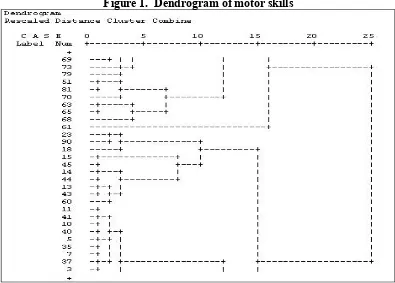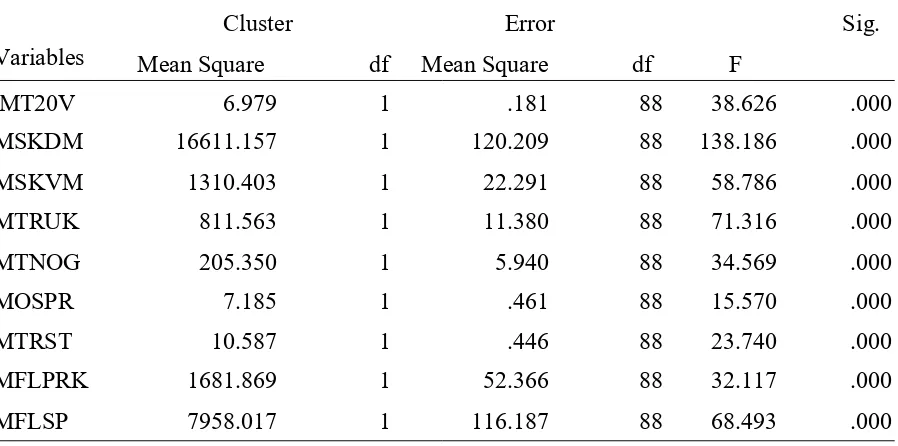Berisha Ajvaz, Koca Afrim, Berisha Kushtrim. Application of taxonomy analysis in selection of young sportsman in karate and football.
Journal of Education, Health and Sport. 2019;9(2):21-29. eISNN 2391-8306. DOIhttp://dx.doi.org/10.5281/zenodo.2555021
http://ojs.ukw.edu.pl/index.php/johs/article/view/6547
The journal has had 7 points in Ministry of Science and Higher Education parametric evaluation. Part B item 1223 (26/01/2017). 1223 Journal of Education, Health and Sport eISSN 2391-8306 7
© The Authors 2019;
This article is published with open access at Licensee Open Journal Systems of Kazimierz Wielki University in Bydgoszcz, Poland
Open Access. This article is distributed under the terms of the Creative Commons Attribution Noncommercial License which permits any noncommercial use, distribution, and reproduction in any medium, provided the original author (s) and source are credited. This is an open access article licensed under the terms of the Creative Commons Attribution Non commercial license Share alike.
(http://creativecommons.org/licenses/by-nc-sa/4.0/) which permits unrestricted, non commercial use, distribution and reproduction in any medium, provided the work is properly cited. The authors declare that there is no conflict of interests regarding the publication of this paper.
Received: 06.01.2019. Revised: 30.01.2019. Accepted: 01.02.2019.
APPLICATION OF TAXONOMY ANALYSIS IN SELECTION OF YOUNG SPORTSMAN IN KARATE AND FOOTBALL
Ajvaz Berisha1; Afrim Koca1; Kushtrim Berisha
1University Hasan Prishtina, Faculty of Physical Education and Sport, Prishtina, Kosova
*Corresponding Author:
Afrim Koca PhD
florian.miftari@uni-pr.edu
University Hasan Prishtina,
Faculty of Physical Education and Sport,
Prishtina, Kosova
Word count: 1580 Abstract word count: 395
ABSTRACT
The selecting represents the optimal selection of that part of the anthropological status that is important for the success in the respective sport and that meets the specific needs of the athlete and also for the potential athlete’s orientation and perfection in terms of certain sports disciplines.
Regarding the selection of the working methods in this research, there were selected those methods which are supposed to help in drawing conclusions about the nature of the problem posed. The sample was defined as students aged 12 years from the Middle School "Selami Hallaqi" Gjilan. In this study is included a total of 90 students, that is, two groups of 45 students. The first group is consisted of students who besides regular hours of physical education 2 times a week also exercised karate two more times a week by one hour per day. The second group comprised of students who besides regular hours of physical education 2 times a week, also exercised football two more times per week, by an hour a day. Measurements were made at the end of the school year. 9 motor variables were applied (Kurelić et al., 1975), running in 20 meters (MT20V), the long jump from the place (MSKDM), high jump from the place (MSKVM), hand taping (MTRUK), leg taping ( MTNOG), eight with bowing (MOSPR), running sideways (mtrs) bowing ahead in the bank (MFLPRK), legs spread apart-retaliation (MFLSP). For the processing of the results it was applied the t-test analysis for independent samples.
The second taxonomy of the motor skills shows that from the 90 students, young sportsmen involved in research, 56 of them can be defined as a student athlete with high motor skills to perform motor movements with explosive character which are well coordinated in time and space, with a top speed of movement segment. Motor dimensions of the explosive strength, speed segment, coordination and flexibility are important motor skills for success in a big number of sports (Findak et al., 1992; Popović, 1998).
Keywords:Students, Selections, Karate, Football, Taxonomy
INTRODUCTION
The determining of the actual situation of children is among the important motor principles in their orientation in the sport for which motor skills are responsible to achieve top results. Also, the definition of motor current situation of children is necessary to determine the current status of their early work to set the work in schools, and at the end of the school year to analyze the effect of the work (Findak et al., 1992) .
Orientation procedures and selection of athletes presents important component of the planning process in sport (Popović, 1998). Selecting the optimal selection represents that part of the anthropological status that is important for success in that specific sport and that meets the determined athlete and sportsman’s orientation and perfection of potential in terms of certain sports discipline. Selection implies a dynamic and continuous process based on estimates forecast, specifically, certain indicators.
The initial selection represents the first selection, which should be given a special attention, because the very early selection enables the identification of potential, namely the identification of high motor skills of children for certain sports and their orientation to engage in the sport. Best would be to start with selection in the sensitive stage of development, or in the earliest possible stage of development, due to the demands of sports, as well as due to the action in the development of certain motor skills and certain anthropological characteristics.
The purpose of this research is based on the taxonomy analysis in the motor variables determining the current motor situation of children and selection of those children with higher motor skills as selected students with great opportunities to achieve top results in the sport Karate.
MATERIAL & METHOD
The sample of the entity consists of students of the age of 12 years old from the Elementary Middle School "Selami Hallaqi" Gjilan. In this study were included a total of 90 students. The first group comprised of students who besides the regular hours of physical education that is 2 times a week, they also exercised in the sport of karate two more times per week, one hour a day. The second group comprised of students who besides the regular hours of physical education that is 2 times a week they also exercised football two more times a week, by one hour per day. Measurements were made at the end of the school year.
For the evaluation of motor skills there were taken nine variables that cover the latent space and energetic and motor processes.
Motor variables applied:
1. Running in 20 METAR (MT20V) 2. Long jump from the place (MSKDM) 3. Long jump from the place (MSKVM) 4. Hand taping (MTRUK)
5. Walk taping (MTNOG) 6. Eights with bowing (MOSPR) 7. Running sideways (MTRS)
8. Bowing ahead in the bank (MFLPRK) 9. Legs sideways-retaliation (MFLSP).
RESULTS
Taxonomy analysis is used for the purpose of forming a sub-sample (sub-sample) with as many similar motor skills as possible. This method is a hierarchical method based on an iterative process (iterative), as a merger of entities in groups, so in the pronounced phase are joined the subjects of previously formed groups, which means that newly formed groups only expand and added to new entities under the motor specifications, and that there is no possibility of transferring subjects from one group formed in the other groups. Motor sub-spaces are covered with two variables, except for the speed in which case the variables are represented by three variables.
Taxonomic analysis results are presented with a dendrogram of motor skills (Figure 1), and show that the structuring of these skills by similarity, based on motor areas defined, clearly show the homogeneity of the investigated sample of students.
Figure 1. Dendrogram of motor skills
Table 1. Basic statistical parameters of motor variables devided into groups
Initial Cluster Centers Final Cluster Centers
Variables Cluster Cluster
1
(N=34) (N=56)2 (N=34)1 (N=56)2
MT20V 4.46 3.74 MT20V 4.66 4.08
MSKDM 107.00 189.00 MSKDM 137.44 166.02
MSKVM 23.00 34.50 MSKVM 26.09 34.16
MTRUK 26.00 33.00 MTRUK 25.85 32.18
MTNOG 23.00 25.00 MTNOG 19.88 22.91
MOSPR 13.29 12.97 MOSPR 14.00 13.40
MTRST 10.73 9.40 MTRST 10.82 10.05
MFLPRK 16.00 33.00 MFLPRK 17.41 26.02
MFLSP 118.00 147.00 MFLSP 115.26 133.66
After reviewing the size of the calculated parameters within descriptive statistics and comparison of the values between the first and second group, it is clear that students involved in sports sections belonging to the second taxonomy dominate at all determined motor skills. At the level of statistically significant variables that young athletes choose in the first taxonomy (Table 2) are motor tests that define all motor sub-areas applied in this research.
Table 2. Taxonomic analysis of the motor variables within and outside isolated groups
Cluster Error
F
Sig.
Variables Mean Square df Mean Square df
MT20V 6.979 1 .181 88 38.626 .000
MSKDM 16611.157 1 120.209 88 138.186 .000
MSKVM 1310.403 1 22.291 88 58.786 .000
MTRUK 811.563 1 11.380 88 71.316 .000
MTNOG 205.350 1 5.940 88 34.569 .000
MOSPR 7.185 1 .461 88 15.570 .000
MTRST 10.587 1 .446 88 23.740 .000
MFLPRK 1681.869 1 52.366 88 32.117 .000
MFLSP 7958.017 1 116.187 88 68.493 .000
.
DISCUSSION
We can conclude that the second taxonomy of motor skills shows that out of the 90 new students involved in the research, 56 of them can be defined as a student athlete with high motor skills to perform motor movements of explosive character which are well coordinated in time and space, with a top speed of movement segment. Motor dimensions of the explosive strength, speed segment, coordination and flexibility are important motor skills for success in numerous sporting disciplines, especially in the sport of karate. The results obtained show the importance that taxonomy analysis in the selection of young athletes in sports for which they have presuppositions.
REFERENCES
Arunovič, D. (1978). Uticaj posebnog programa nastave fizičog vaspitanja (sa akcentom na košarku) na neke motoričke sposobnosti učenika uzrasta 15-15 godina. Magistarska teza, Fakultet za fizičku kulturu, Beograd.
Findak,V., Metikoš,D., & Mraković. M. (1992). Kineziološki priručnik za učitelje. Zagreb: hrvatsko pedagoško - književni zbor.
Findak, V. (1992). Metodički organizacijski oblici rada u edukaciji, športu i športskojrekreaciji.
[Methodological organisational work forms in education, sport and sportrecreation.] Zagreb: Hrvatski savez za športsku rekreaciju, MENTOREX.
Ismail, A.H. (1976) Djelovanje dobro organiziranog programa fizičkog odgoja na intelektualni status.Kineziologija, Zagreb, vol. 6, br. 1-2, str. 29-37.
Kurelić, N., Momirović, K., Stojanović, M., Šturm, J., Radojević, Đ., & Viskić-Štalec, N. (1975). Struktura i razvoj morfoloških i motoričkih dimenzija omladine. Beograd: Institut za naučna istraživanja Fakulteta za fizičko vaspitanje.
Popovic, R. (1998). Antropološke determinante u uspehu u ritmicko-sportskoj gimnastici. Niš: SIA.
Popovic, R. Teorijska analiza problematike izbora sportskih talenata i izbora kriterijuma uritmickoj gimnastici. 2002; Godi{njak 11. 183–207.


